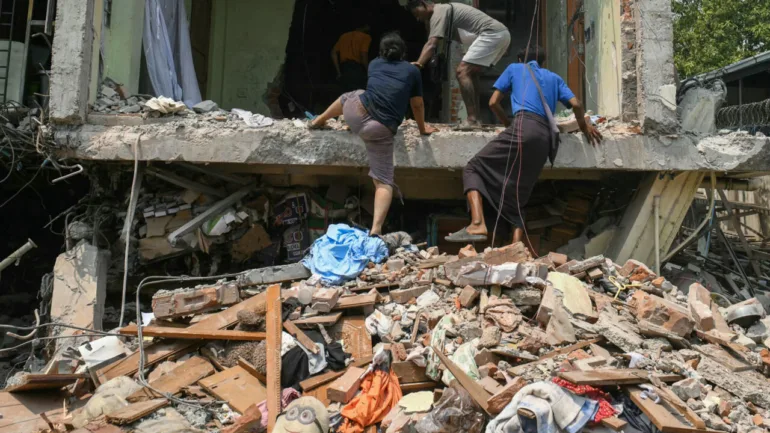The death toll from a massive earthquake that struck Myanmar and Thailand surpassed 1,000 on Saturday, as rescue teams worked tirelessly to search for survivors amidst the wreckage of collapsed buildings.
The 7.7-magnitude quake, which struck northwest of the city of Sagaing in central Myanmar on Friday afternoon, was followed minutes later by a powerful 6.7-magnitude aftershock. The tremors caused widespread devastation, destroying buildings, downing bridges, and damaging roads across Myanmar. Mandalay, the country’s second-largest city with over 1.7 million people, was particularly hard-hit.
“We need aid,” said Thar Aye, 68, a resident of Mandalay. “We don’t have enough of anything.”
As of Saturday, at least 1,007 people had been confirmed dead in Myanmar, with nearly 2,400 others injured and 30 still missing, according to a statement from the military junta. In Bangkok, around 10 deaths have been confirmed. However, due to disrupted communications, the true scale of the disaster is only beginning to emerge, and the death toll is expected to rise significantly.
In Mandalay, more than 90 people are feared trapped under the collapsed Sky Villa Condominium, where multiple floors pancaked on top of each other. Rescuers are working frantically to free survivors.
The earthquake, the largest to hit Myanmar in decades, also caused severe damage in neighboring Thailand. The tremors were strong enough to shake buildings in Bangkok, hundreds of kilometers from the epicenter. In Mandalay, AFP journalists reported seeing a centuries-old Buddhist pagoda reduced to rubble.
“It started shaking, then it got serious,” said a soldier stationed at a checkpoint near the pagoda. “The monastery collapsed. One monk died, and some people were injured. We helped pull out survivors and took them to the hospital.”
At Mandalay Airport, the ceiling of the terminal collapsed, forcing the airport to close, further complicating rescue and relief efforts in a country already struggling with the effects of a civil war since the military coup in 2021.
In an unprecedented move, Myanmar’s junta leader, Min Aung Hlaing, issued a rare plea for international aid on Friday, acknowledging the scale of the disaster. The government declared a state of emergency in the six worst-affected regions. At a major hospital in Naypyidaw, medics were forced to treat patients outdoors due to the damage to facilities.
International assistance began arriving on Saturday, with the United States pledging aid, and an Indian flight carrying essential supplies, including hygiene kits and food, landing in Yangon. China sent a team of 82 rescuers to assist in the recovery efforts.
Aid agencies have raised concerns that Myanmar is ill-prepared to handle a disaster of this magnitude. Prior to the earthquake, over 3.5 million people in the country had already been displaced by ongoing conflict, and many were at risk of hunger.
Across the border in Bangkok, rescuers searched through the night for survivors after a 30-story skyscraper under construction collapsed, reduced to rubble in seconds by the earthquake’s tremors. Bangkok Governor Chadchart Sittipunt confirmed that around 10 people had been killed in the collapse, while up to 100 workers remain unaccounted for.
Authorities deployed thermal imaging drones to detect signs of life in the debris and have identified potential survivors. In total, more than 100 engineers have been sent to inspect buildings for safety, following over 2,000 reports of damage. Around 400 people were forced to spend the night outdoors, as their homes were deemed unsafe.
While widespread destruction was not seen in Bangkok, the tremors caused dramatic scenes, including rooftop swimming pools spilling over the sides of high-rise buildings. Even hospitals were evacuated, with one woman delivering her baby outdoors after being moved from a hospital building.
As both countries continue to grapple with the aftermath of this devastating earthquake, the full extent of the damage remains unclear, and the search for survivors is ongoing.


